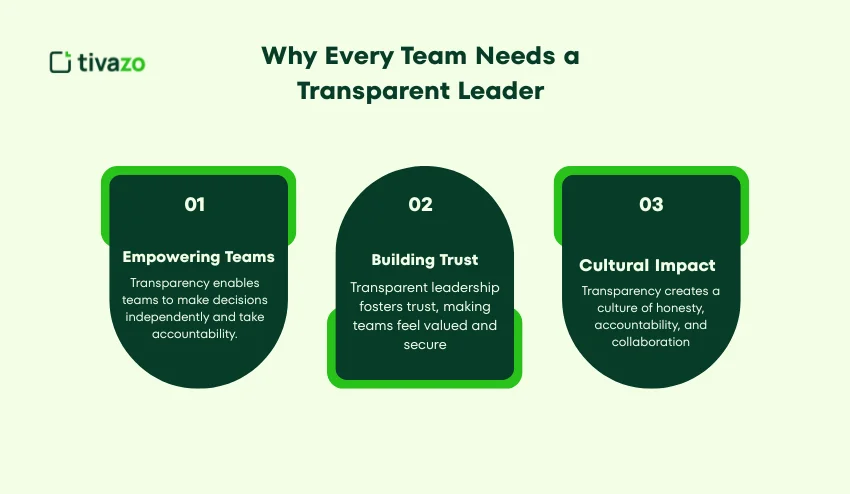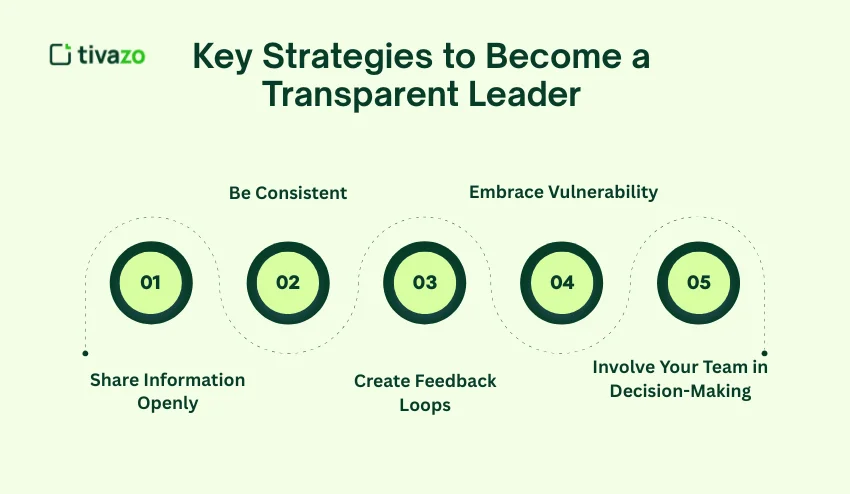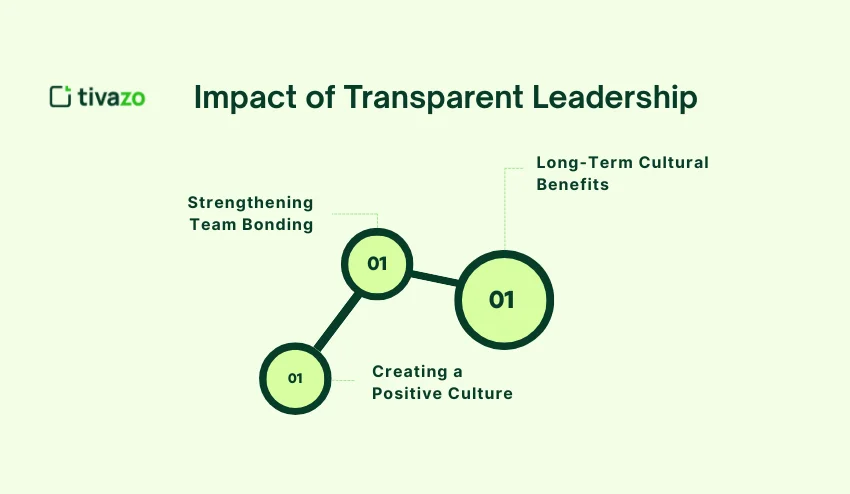In today’s increasingly fast business climate, leadership is less about simply being in charge and more about how you can connect and empower your coworkers. One of the most impactful traits a leader can possess is transparency – that is, leading with honesty, openness, and trust.
Transparent leadership is the secret sauce to creating cohesive, motivated, and effective teams. Whether you lead a remote team or a traditional office, creating transparency can strongly influence your team’s morale, productivity, and loyalty.
So how do you become a transparent leader? Here are our top 5 ways to not only build trust, but to increase the success of your team too.
Key Highlights:
- What Is a Transparent Leader
- Importance of a Transparent Leader
- Key Strategies to Become a Transparent Leader
- Overcoming Common Challenges of Transparent Leadership
- Transparent Leadership Enhances Team Collaboration
- The Impact of Transparent Leadership on Company Culture
What Is a Transparent Leader?
Transparent leaders focus on honesty and open communication. For example, they are open about the challenges the company faces, what and how decisions are made, and are engaged with feedback. While traditional leadership is focused on a top-down approach, a transparent leader leads by breaking down the barriers and sharing information (good and bad), and collaborates with the team to make decisions. Not only does this build trust, but it also creates a collaborative culture where teammates feel that their input is valuable and encouraged to contribute their thoughts.
Why Is Transparent Leadership Important?
Transparent leadership is important because it provides an atmosphere where employees feel informed, appreciated, and capable of acting. When leaders are communicative about the organization’s goals, challenges, and decisions regarding the business, it deepens relationships and creates a culture of collaboration and excellence. Here are some of the reasons transparency is vital for any successful team:
- Trust – Transparency creates trust, which is the cornerstone of a high-performing team. If you are transparent in your leadership, employees feel safe in their roles and contribute more productively.
- Collaboration – Team members collaborate more effectively when they all have access to the same information, which fosters greater conversations and better problem resolution.
- Retention – Employees are more likely to stay at organizations that exhibit transparency. Transparency creates more engagement, higher levels of satisfaction, and is less likely to lose employees.
Why Every Team Needs a Transparent Leader
Being a transparent leader is not just a great quality; it can change everything for any team. Where leaders share transparently, contributions, collaboration happen a lot faster. Here is why transparency is an essential quality of any successful team:

1. Empowering Teams
When leaders are vulnerable and honest, they empower their teams to make informed decisions on their own. Empowered teams are more confident and capable of solving problems on their own, which will free a leader to focus on strategic thinking. An empowered team is possible when leaders equip their teams with the right information and context to do so. Once equipped, the team members will take accountability for their work, and that contributes to your organization.
2. Building Trust
When leaders are transparent, they communicate to their teams that they can be trusted and valued. By creating an environment where trust reciprocates, work culture improves, and team members feel safe to share ideas or challenges. Trust also mitigates fears about job security, future organizational direction, and allows employees to focus on a greater effort at work. A trusting team functions better and has never-ending enthusiasm to accomplish work because team members enjoy working for a leader they trust.
3. Cultural Impact
Transparency provides the underpinning of a strong team culture. Transparency improves levels of honesty, increased accountability, and shared responsibility, all of which improve the health of the workplace. When leaders are transparent, they set the environment for all team members to feel comfortable communicating freely and hold one another accountable. Furthermore, transparency sets up a culture of collaboration and shared efforts to achieve common work.
5 Key Strategies to Become a Transparent Leader
5 Key Strategies to Become a Transparent Leader are:

1. Share Information Openly
The first step of transparency stems from open communication, beginning with sharing information with your team. In a leadership role, open communication can mean sharing important information with your team concerning company goals and obstacles, and if the direction has changed, sharing this allows your team to be well-informed and included so that everyone is moving in the same direction. This creates an atmosphere of trust among your team, lessens the chances of people being confused, and holds every person accountable.
- Assists teams to feel engaged in the success and direction of the company.
- Ominously prevents misunderstandings and rumors from occurring.
- Creates trust and rapport as a show of open communication.
- Creates team alignment on goals and expectations.
Tip: Create an online team calendar or scheduler that can serve as a central hub for your routine updates (ex., monthly town halls or weekly emails) so the team doesn’t forget..
2. Be Consistent and Honor Your Commitments
Effective leadership is vital to trust building, and when you commit to your team, either through promises or commitments, you must continue the practice to show reliability and trustworthiness. You must maintain the integrity of your word and, when actions do not match words, you begin to lessen the trust that you are trying to build.
- Demonstrates consistency and respect for your team’s time.
- Reinforces team culture and trust.
- Solidifies your leadership when your speech and actions align.
- Promotes clarity and safety with respect to feeling secure in their role on the team.
3. Create Feedback Loops and Encourage Input
As part of transparent leadership, ask your team for feedback. Open feedback loops promote a team culture in which members feel heard and valued, which provides useful data that can improve a process or a project. You can create collaboration and engagement in terms of developing the team or the company.
- Encourages ongoing improvement by asking for team feedback.
- Enables open discussions that help team colleagues feel heard and valued.
- Improves decision-making through multiple perspectives from the team.
- Encourages a growth mindset and flexibility.
Tip: Invite the use of other platforms and mechanisms to achieve the 360-degree feedback concern. Slack channels, surveys, and routine 1-on-1 meetings can ensure involvement and participation. This can apply to team feedback, processes, goals, and leadership style.
4. Embrace Vulnerability and Admit Mistakes
Transparent leadership and communication is not just about sharing what is going well, it is actually the opposite. It is admitting is a mistake, and showcasing your humanness by admitting vulnerability. Leaders who are willing to lead by example and do this can cultivate an open and safe environment, which leads to team members taking action. This translates to continuous improvement, and allows team members to connect on a deeper level.
- Promotes a culture of learning and improvement.
- Establishes psychological safety, letting team members feel safe to fail and learn.
- Allows more authenticity, and make team members understand that you are human too.
- Assists in developing resilience by focusing on solutions instead of on blame.
5. Involve Your Team in Decision-Making
Transparent leadership and communication is all about including your team to make decisions. Leaders should especially involve their team when making decisions that will impact their team. Involving your team creates ownership and gives purpose that aligns with one another, which leads to better collaboration.
- Creates alignment to the company goals and objectives.
- Collaborates better, because team members feel that their contributions are valued.
- Establishes ownership of the outcomes of the company, which increases team morale and motivation.
- Also gains the perspective of the team beyond the leader’s perspective, and learn about diverse perspectives and options.
Overcoming Common Challenges of Transparent Leadership
Though transparent leadership can build trust and productivity, there are challenges that come with that. Here is how to surmount these challenges and continue to be a good and open leader:

1. Fear of Over-sharing
One common fear leaders struggle with is the intrusion of rapport that may come as a result of too much information shared, which can overwhelm or confuses. Leaders play tricks on themselves, thinking that sharing information with too much information could be a stressor or distractor for the team, but this is the nature of transparent leadership; it does not mean share everything, it means share the right and important information.
2. Managing Sensitive Information
There will be a time when there are some pieces of information that have to remain private regarding financial matters, personal matters, or company strategy. Transparent leaders will recognize that not every detail can be shared with the team, and not sharing information does not mean they are being dishonest.
3. Balancing Authority and Transparency
Another challenge is frankly the fear that transparency will erode a leader’s authority or lead to a lack of respect for the leader. A leader may worry they will appear weak or indecisive if they are too transparent. The truth is that transparency builds trust; when people trust a leader and trust each other, authority is strengthened. Balancing authority and transparency is an important practice.
How Transparent Leadership Enhances Team Collaboration
Transparent leadership is key to team collaboration. When a leader is clear about goals, challenges, and decisions, any team member has the opportunity to make a contribution based on the availability of information. Transparency catalyzes a team to connect as one, work collaboratively, and be more efficient. Transparent leadership specifically achieves the following to promote collaboration:
1. Open Discussions
A culture of openness will support these honest discussions, which are essential for both problem-solving and innovation. When leaders are transparent with both their successes and their failures, it allows people to feel safe in sharing their opinions, suggestions, and concerns. This creates a culture of collaboration as people feel less risk in voicing their opinions outside the norms of compliance and judgment.
- Builds Trust and Safety: When team members understand that their input was genuinely appreciated, they can also feel more compelled to speak up, as they know their ideas will not be challenged.
- Encourages Idea Sharing: Open conversations stimulate many different opinions and suggestions, which can lead to creative solutions.
2. Breaking Down Silos
When information is free flowing, from the leadership level and all the way down the organization, the walls that restrict teams from one another, through the illusion of competing, collaborative effort is compromised. Transparent leadership also takes fear away from running ideas or options across all functions.
- Increases Knowledge Sharing: There is a whole organization working together and supporting one another to create an environment that improves the speed of problem-solving.
- Stronger Cross-Departmental Collaboration: Increased awareness of how and what other departments or teams are working on naturally leads to an orchestrated effort.
3. Creating Shared Goals
When all members of the team are unified, it is easier to gather everyone around common goals. Transparent leadership helps team members understand their company’s mission, vision, and goals while also understanding how their individual work connects to that larger mission. And when employees understand how their work a higher purpose, they will be motivated to work toward a more collective common goal.
- Strengthens Motivation and Engagement: Employees are more motivated when they recognize the actual work done contributes to the success of the company and they see their work being directed toward a collective effort.
- Aligns Work Across Teams: Transparent leaders will help ensure work across all teams align with the goals that supports the company’s strategic goals.
The Impact of Transparent Leadership on Company Culture
Transparent leadership is more than just about decisions; it lays a strong groundwork for positive, open, and flourishing company culture. Let’s examine the key advantages:

1. Creating a Positive Culture
When leaders model transparent leadership, it sets a standard for respect and inclusiveness. Employees do in fact feel valued as a result of being transparent, producing a culture of trust and collaboration.
2. Strengthening Team Bonding
Transparent communication can eliminate barriers and has the power to build a culture of teamwork. Teams that share openly, communicate freely, and share information are more connected. The result is collaboration and respect.
3. Long-Term Cultural Benefits
Transparent leadership creates a culture of resiliency and adaptability. It builds employee loyalty and employee retention because people feel safe in workspaces that empower honest and openness.
Conclusion: Becoming a Transparent Leader for Long-Term Success
Transparent leadership has its advantages: enhanced collaboration, improved morale, and stronger team performance. You can create a climate that fosters trust, openness, and innovation by employing these 5 principal strategies.
Are you ready to step into a leadership role with transparency? Begin by taking one small action today; share information, ask for feedback, or admit an error. You’ll be amazed at the response.




